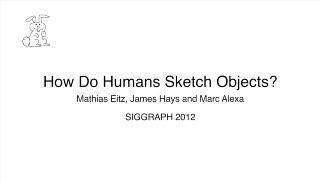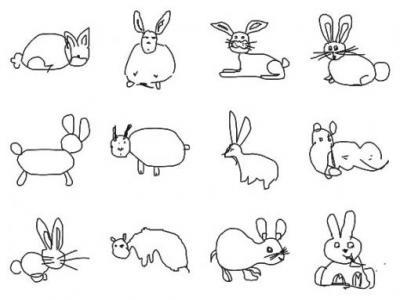Getting a computer to understand what we've come to understand through years of cartoons and coloring books is a monumentally difficult task. The key to making this new program work, Hays says, is a large database of sketches that could be used to teach a computer how humans sketch objects. "This is really the first time anybody has examined a large database of actual sketches," Hays said.
To put the database together, the researchers first came up with a list of everyday objects that people might be inclined to sketch. "We looked at an existing computer vision dataset called LabelMe, which has a lot of annotated photographs," Hays said. "We looked at the label frequency and we got the most popular objects in photographs. Then we added other things of interest that we thought might occur in sketches, like rainbows for example."
They ended up with a set of 250 object categories. Then the researchers used Mechanical Turk, a crowdsourcing marketplace run by Amazon, to hire people to sketch objects from each category — 20,000 sketches in all. Those data were then fed into existing recognition and machine learning algorithms to teach the program which sketches belong to which categories. From there, the team developed an interface where users input new sketches, and the computer tries to identify them in real time, as quickly as the user draws them.
As it is now, the program successfully identifies sketches with around 56-percent accuracy, as long as the object is included in one of the 250 categories. That's not bad, considering that when the researchers asked actual humans to identify sketches in the database, they managed about 73-percent accuracy. "The gap between human and computational performance is not so big, not as big certainly as it is in other computer vision problems," Hays said.
The program isn't ready to rule Pictionary just yet, mainly because of its limited 250-category vocabulary. But expanding it to include more categories is a possibility, Hays says. One way to do that might be to turn the program into a game and collect the data that players input. The team has already made a free iPhone/iPad app that could be gamified.
"The game could ask you to sketch something and if another person is able to successfully recognize it, then we can say that must have been a decent enough sketch," he said. "You could collect all sorts of training data that way."
And that kind of crowdsourced data has been key to the project so far.
"It was the data gathering that had been holding this back, not the digital representation or the machine learning; those have been around for a decade," Hays said. "There's just no way to learn to recognize say, sketches of lions, based on just a clever algorithm. The algorithm really needs to see close to 100 instances of how people draw lions, and then it becomes possible to tell lions from potted plants."
Ultimately a program like this one could end up being much more than just fun and games. It could be used to develop better sketch-based interface and search applications. Despite the ubiquity of touch screens, sketch-based search still isn't widely used, but that's probably because it simply hasn't worked very well, Hays says.
A better sketch-based interface might improve computer accessibility. "Directly searching for some visual shape is probably easier in some domains," Hays said. "It avoids all language issues; that's certainly one thing."

To develop a program that allows computers to recognize rough sketches, we need to understand how humans actually sketch objects. Researchers from Brown University and the Technical University of Berlin collected 20,000 sketches, and developed a computer program that can recognized sketched objects in real time.
(Photo Credit: Mathias Eitz, James Hays and Marc Alexa)

Computers can recognize photos and careful drawings of rabbits, but quick sketches by non-artists ... not so much. Researchers in Providence and Berlin say they have produced the first computer application that enables semantic understanding of abstract sketches.
(Photo Credit: Mathias Eitz, James Hays and Marc Alexa)
Source: Brown University